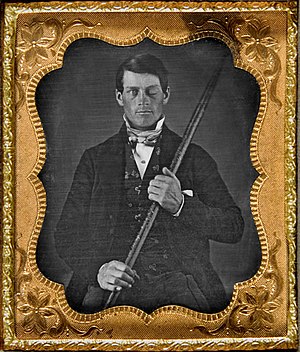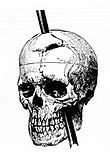Phineas P. Gage | |
|---|---|
 | |
| Born | July 9, 1823 (date uncertain) |
| Died | May 21, 1860 (aged 36) San Francisco Bay Area, California, U.S. |
| Cause of death | Status epilepticus |
| Burial place | Cypress Lawn Memorial Park, California (skull in Warren Anatomical Museum, Boston) |
| Occupations |
|
| Known for | Personality change after brain injury |
| Spouse | None |
| Children | None[M]: 39,319,327 [1] |
Phineas P. Gage (1823–1860) was an American railroad construction foreman remembered for his improbable[B1]: 19 survival of an accident in which a large iron rod was driven completely through his head, destroying much of his brain's left frontal lobe, and for that injury's reported effects on his personality and behavior over the remaining 12 years of his life—effects sufficiently profound that friends saw him (for a time at least) as "no longer Gage".

Long known as the "American Crowbar Case"—once termed "the case which more than all others is calculated to excite our wonder, impair the value of prognosis, and even to subvert our physiological doctrines" [2]—Phineas Gage influenced 19th-century discussion about the mind and brain, particularly debate on cerebral localization,
Gage is a fixture in the curricula of neurology, psychology, and neuroscience,
A report of Gage's physical and mental condition shortly before his death implies that his most serious mental changes were temporary, so that in later life he was far more functional, and socially far better adapted, than in the years immediately following his accident. A social recovery hypothesis suggests that his work as a stagecoach driver in Chile fostered this recovery by providing daily structure that allowed him to regain lost social and personal skills.
Cite error: There are <ref group=note> tags on this page, but the references will not show without a {{reflist|group=note}} template (see the help page).
- ^ Cite error: The named reference
northstarwas invoked but never defined (see the help page). - ^ Cite error: The named reference
campbellwas invoked but never defined (see the help page). - ^ Cite error: The named reference
larnerwas invoked but never defined (see the help page). - ^ Macmillan (2000), ch. 13; Macmillan (2008), p. 830.
- ^ Cite error: The named reference
mazzoniwas invoked but never defined (see the help page).